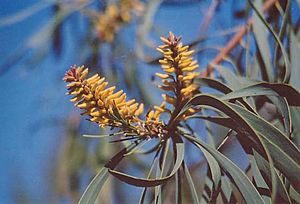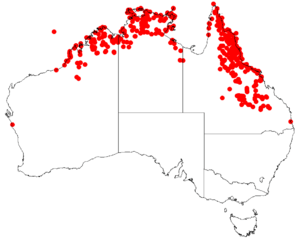Wild pear facts for kids
Persoonia falcata, often called the wild pear, is a type of shrub or small tree. It grows naturally in the northern parts of Australia. This plant is known for its interesting leaves and edible fruit.
Quick facts for kids Wild pear |
|
|---|---|
 |
|
| Scientific classification | |
| Genus: |
Persoonia
|
| Species: |
falcata
|
 |
|
| Occurrence data from Australasian Virtual Herbarium | |
| Synonyms | |
|
Linkia falcata (R.Br.) Kuntze |
|
Contents
Naming the Wild Pear
Scientists give plants special names so everyone knows exactly which plant they are talking about. The wild pear was first officially described by a Scottish botanist named Robert Brown in 1810. He found it near the Endeavour River in what is now northern Queensland.
The second part of its scientific name, falcata, is a Latin word. It means "sickle-shaped." This name was chosen because the leaves of the wild pear often look like a curved farm tool called a sickle.
Local Aboriginal people have their own names for this plant. The people of Groote Eylandt call it awulka in their Enindhilyagwa language. The people of Yirrkala call it dangapa in the Rirratjingu language.
What Does it Look Like?
The wild pear can grow as a woody shrub or even a small tree. It can be anywhere from 1 to 9 meters (about 3 to 30 feet) tall. Its bark is thick, dark grey, and often peels off in layers.
The leaves are a pale green-grey color. They are quite long, usually between 8 and 35 centimeters (about 3 to 14 inches). They are also narrow, about 0.4 to 3 centimeters (0.15 to 1.2 inches) wide. Many of them have that unique curved, sickle-like shape.
Flowers and Fruit
Bright yellow flowers appear on the wild pear from June to November. After the flowers, the plant produces yellow-green fruits. These fruits are called drupes, which means they have a fleshy outside and a hard pit inside, like a peach.
The fruits usually appear from October to February. They are edible and have been eaten raw by local Aboriginal people for a long time.
Where Does it Grow?
The wild pear is found across a large area of northern Australia. You can usually find it within 300 kilometers (about 186 miles) of the coastline. It grows in the northwest of Western Australia, including the Great Sandy Desert and near Broome.
It also spreads eastward across the Northern Territory and into northern Queensland. The Blackdown Tableland marks the furthest southeastern point where it grows.
Preferred Habitat
This plant likes to grow near water. You can often find it along rivers, in gorges, and on sandstone rock formations. It usually prefers soils that are sandy or made from river deposits. Sometimes, it can also be found on soils that come from granite or laterite, and very rarely on clay.
The wild pear grows in open woodlands. These woodlands often have Eucalyptus trees, Melaleuca trees, or a mix of different tree types.
Traditional Uses
Growing the wild pear in gardens has been tricky. Attempts to plant it at the Royal Botanic Gardens in Sydney and Melbourne have not been successful.
However, Aboriginal people have traditionally used parts of the wild pear for various purposes. They would make a special liquid from the wood and bark to use as an eye wash. They also drank a tea made from the leaves to help with chest colds and diarrhea. Sometimes, leaves were even placed directly on wounds.

